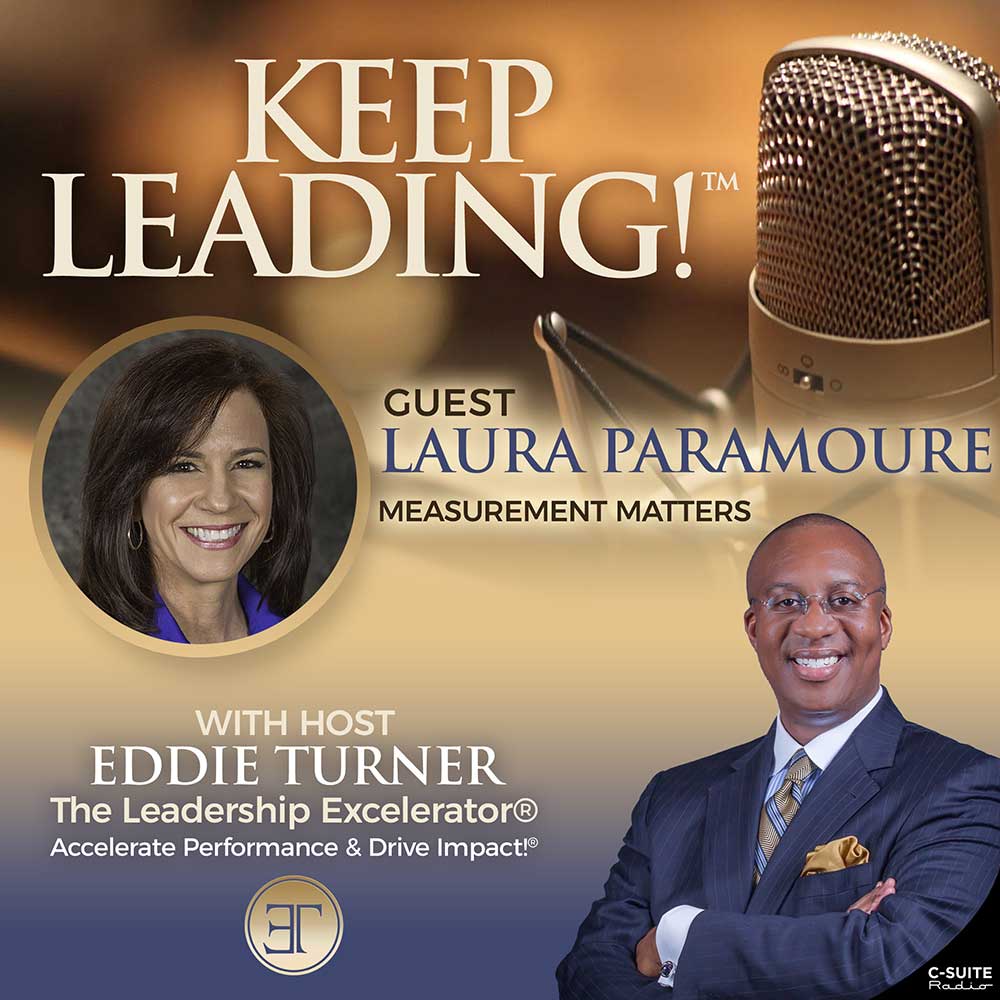Laura Paramoure
President at eParamus, Speaker on Training ROI
Measurement Matters
Episode Summary
How effective are you at what you do for a living? How do you know? Are you measuring your effectiveness? In this episode, Dr. Laura Paramoure and I discuss the reason measurement should matter to all of us as leaders.
Bio
Laura Paramoure, EdD, has more than 25 years of academic and private sector experience in organizational development, performance improvement, and training design and delivery. In addition to completing extensive secondary literature reviews Dr. Paramoure conducted primary research to develop thought leadership on training effectiveness and measurement. Dr. Paramoure is the author of ROI by Design™ (2014); and Perceptions of training and non-training managers of organizational impact measures based on design intent(2001).
Laura completed her Ed.D. at North Carolina State University with major study in Adult Education and a specialization in Organizational Development, a master’s degree in organizational communication from North Carolina State University and a BBA degree in Marketing from Kennesaw State University.
Website
www.eparamus.com
LinkedIn
https://www.linkedin.com/in/laura-paramoure-31019b13/
Twitter
https://twitter.com/eParamusLLC/
Leadership Quote
“You cannot lead if you do not inspire others to follow.”
Transcript
This podcast is part of the C Suite Radio Network, turning the volume off on business.
Welcome to the Keep Leading Podcast, a podcast dedicated to promoting leadership development and sharing leadership insights. Here’s your host, the Leadership Excelerator, Eddie Turner.
This podcast is sponsored by Eddie Turner LLC. Eddie Turner LLC delivers executive and leadership coaching, professional speaking, facilitation services, and management consulting across the globe. Eddie Turner LLC also creates voiceovers, serves as a master of ceremonies, as a panel and event moderator, and provides national media commentary. Visit EddieTurnerLLC.com to learn more.
Hello, everyone. Welcome to the Keep Leading Podcast, the podcast dedicated to leadership development and leadership insights. I’m your host Eddie Turner the Leadership Excelerator. I work with leaders to accelerate performance and drive impact.How effective are you at what you do for a living? How do you know? Are you measuring your effectiveness? Well, my guest today is an organizational development and performance improvement expert. She will explain the reason measurement should matter to us all. I’m delighted to welcome Dr. Laura Paramoure.
Dr. Laura, welcome to the Keep Leading Podcast.
Speaking of the Apple watch, mine is telling me I should stand right now but we’ll ignore that. You’re absolutely right, Dr. Laura. So that’s the point you’re driving. Yes we are collecting data all the time now and in new ways that we never even conceived of before. And so every aspect of our life revolves around data, revolves around measurement. So we absolutely as leaders, to have credibility, must take numbers serious, must take measurements serious.So if I want to do better as a leader and have a framework for how I measure, how can I do that? Do you have a way of helping me?
Yes certainly but I just want to make the point that it’s not really about the numbers. I mean, of course, measurement turns into numbers. How much something has changed can be quantified but it’s really about doing our jobs as leaders and that we are having a focused process to identify the change and that’s what measurement provides. It’s not necessarily just about the numbers. It’s about the data on the change. So with respect to a model we can follow, it always follows those four steps that I mentioned. So as leaders we assess the organizational health by reviewing metrics in the organization, right? So we look and we see if we are a leader and we have a team that works for us, we’re looking at productivity metrics or error metric or certain metrics that are important in our department. When we look at those metrics, that tells us about the health of our department. And so we react to those metrics. If we have a high number of error, we know “Okay, we need an intervention here. We need something to reduce those errors.” So metrics become a benchmark for us understanding how organization is doing.And once we look at those and we make a determination we need some intervention, then we’ll go in and say “Okay, as leaders we may need to provide training” or “We may need to be able to provide technology or something that we believe will change that gap that we see in our metrics. So that’s where we conceptualize the solutions or the interventions to fill those gaps. And then senior leaders need to clearly define those goals for that intervention. And when they state those goals in business actions, it creates the transparency, establishes trust and kind of enables the achievement of those standards that are identified. So it’s necessary for leaders to first analyze where the organization is, then determine the gaps and create an intervention. Once they’ve created that intervention and let’s just say they do a leadership program and they implement that leadership program, then they have to kind of take a look at the organization and say “Is that organization applying that? Is there an acceptance of those changes?” so that the intervention doesn’t fall flat in the organization because really the value comes in whether the organization changes, right? So the application stage is the point where most leadership initiatives fail. So measuring failure at that stage kind of provides the most information on the organization’s ability and readiness for change.
And finally, if you can get past that application stage, then you revisit the that analysis, those metrics you’re looking for and see whether those metrics changed and the final step is verification that the solutions made the difference in the organization that that leader targeted.
Well, wonderful. Thank you for sharing that with us – To Prepare, To Measure.Well, we’re going to prepare to take a break at this time and have a word from our sponsor.
This podcast is sponsored by Eddie Turner LLC. Organizations who need to accelerate the development of their leaders call Eddie Turner, the Leadership Excelerator. Eddie works with leaders to accelerate performance and drive impact. Call Eddie Turner to help your leaders one on one as their coach or to inspire them as a group through the power of facilitation or a keynote address. Visit EddieTurnerLLC.com to learn more.
This Lou diamond from Thrive LOUD with Lou Diamond and you’re listening to the Keep Leading Podcast with Eddie Turner.
I’ve seen it in many, many different ways. I’ll give you one example which I’m sure will resonate. We worked with a company that’s in the oil and gas industry in the Middle East. And typically in that region the leaderships are very hierarchical with a clear distinction between leaders and followers. So sharing the method of a model, in their analysis, the first step, the leaders determined they wanted to share the culture of the organizations towards employees having more autonomy, accountability, and kind of embracing innovation because in that culture that’s not something that they normally do. The leaders were feeling like they needed to make that shift to enable their ability to compete in the growing kind of world industry of oil and gas to really compete. So they looked at the organization and said “In order for us to meet the industry where it is and where we’re seeing it going, we need to enable our leaders to have some of that accountability and to embrace innovation.” They looked at some of their metrics and they said “We feel like if we were able to do this, we could increase productivity, we could reduce errors because people would be willing to speak up, and then they would be more willing to provide innovation.”So they were looking at metrics around productivity, errors, and innovation. So what they did was the intervention they determined, the main one was to create a culture change that was extensive to leadership development through coaching. So they wanted to create a shift starting with the development of new leaders in the organization. They had already decided that they needed to have an employee development through coaching but this was a new group of leaders coming through and they were going to impart this new methodologies, new culture shift into their training. So the leadership coach identified kind of key leadership skills and the behavior indicators that would verify achievement of those skills. And he worked with each one of those leaders to acquire the mindset of a leader and to kind of master the actions of the leader. You being very familiar with coaching, you realize that they go in and they support those leaders as they’re moving through those phases. The objectives and the measurements that they used in the leadership program were shared with all the participants.
So, in other words, they said “To be a leader, this is kind of the mindset of a leader. These are the things that leaders do and this is what it looks like when they do it.” So that kind of provided them with a clear definition of expectations and then kind of gave them confidence when those expectations were met. So you can view this in a measurement perspective of the measurement of preparing, you were preparing what that measurement was on the frontend so that when you put that intervention in, everyone was able to get on board to be able to make the change. You can imagine that a lot of times when you take learning course or you’re trying any development program, sometimes they’ll say “You go and you need to have better communication.” That’s great. We kind of all go in there and we get a lot of conversation about what communication is and how you should share it, etc. And we come out of a learning course and we go “Okay, that was all great information but what does that look like in my job?”
So in this process they were giving really clear definitions of what those leadership behaviors are and supporting them in feeling confident in those. So when they moved on to the acceptance side or the application side, once a coach was satisfied that the leaders had acquired those behaviors, then they went in and reviewed the progress of the leaders to see if the job environment was supportive of the new methods that they were using. And when they investigated this, they uncovered things within the organization outside of participant’s ability that inhibit that culture shift and the new leadership methods that were employed. For instance, one of the things they discovered was the managers of the new leaders, not the new leaders who went through the program but the managers of the new leaders, they were prohibiting the use of those new leadership methods. So you can imagine if you go in and you teach middle managers, the kind of new leaders, how to be more less punitive with their people and be able to ask them to be more innovative and support innovation, if the managers above them are not supporting that, then it wouldn’t be applied very well, right?
So, when they were checking for the acceptance of the application in the organization, that’s one of the things they found. So that enabled the senior leaders to go in and address that with the leaders that were creating that barrier to application.And then finally after they could see the application phase was completed, they went in and looked at the impact that they had. So the senior leaders kind of went back and reviewed the targeted metrics to determine if the changes to leaders had really had the expected change in the organizational metrics. They discovered the targeted productivity and the error metrics from the departments of the new leaders showed improvement over the other departments. However, the innovation metric did not show improvement. So the measurement itself showing whether those behaviors were being applied gave us indication is to we knew that the intervention happened, that the application happened and then we could see which of the metrics were impacted by that application. The innovation metric wasn’t impacted even when the leaders had made all those changes. And so what they learned when they investigated on that was that employees working for the new leaders were still hesitant to make suggestions regardless of the way the new leaders were treating them because they didn’t want to make improvements or innovations because they had that ingrained culture and fear of failure. So that was completely outside of the control of their managers. The managers were still providing the environment that the coach had requested but the employees still had the fear, so they didn’t make the change. So getting that data helped identify other areas where development was needed. When they got that feedback, they decided to reinforce the necessary shift in the employees by instituting a merit-based compensation and employee recognition program.
So you can see how each one of those phases they learned something by measuring at each one of those steps and they’re measuring the same thing, they’re measuring the intended results as it moves through the intervention phase, the application phase, and then finally the impact phase. And that measurement gave them the confidence to make decisions to improve the results but also to determine whether or not the initiatives they put in actually made the impact that they had expected.
Well, thank you very much.Now, I would say that if I were to put all together, Dr. Laura, what I’m hearing you say as we should actually think about measuring the impact of business no matter what role we are in a business and that it is doable and that it’s vital for every professional in every profession.
Well, thank you for giving me something to summarize and sharing all of your insights with us today.Well, on the Keep Leading Podcast we Want to make sure we give leaders something to think about in addition to everything you just shared with us, a short quote or short story that they can use to keep leading. What would you share with our leaders who are listening to us today?
I like that. Thank you. “You cannot lead if you do not inspire others to follow.”Where can people learn more about you, Dr. Laura?
Fantastic. Well, all of that will be in the show notes. So if you’re driving and doing other things, don’t worry about it. On your mobile device you’ll see it right there on your show notes or on the computer. We want to definitely make sure that you get connected to Dr. Laura and to eParamus.Dr. Laura, thank you again for being a guest on the Keep Leading Podcast today.
Thank you for listening to your host Eddie Turner on The Keep Leading Podcast. Please remember to subscribe to The Keep Leading Podcast on iTunes or wherever you listen. For more information about Eddie Turner’s work please visit EddieTurnerLLC.com.
Thank you for listening to C Suite Radio, turning the volume up on business.
The Keep Leading!™ podcast is for people passionate about leadership. It is dedicated to leadership development and insights. Join your host Eddie Turner, The Leadership Excelerator® as he speaks with accomplished leaders and people of influence across the globe as they share their journey to leadership excellence. Listen as they share leadership strategies, techniques and insights. For more information visit eddieturnerllc.com or follow Eddie Turner on Twitter and Instagram at @eddieturnerjr. Like Eddie Turner LLC on Facebook. Connect with Eddie Turner on LinkedIn.




